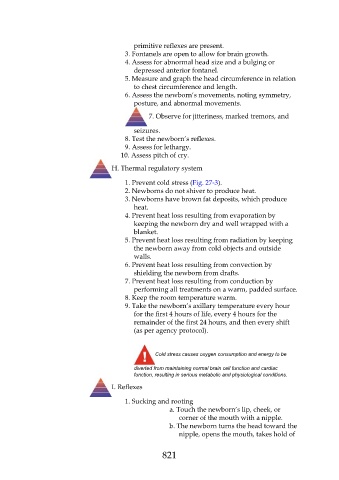Page 821 - Saunders Comprehensive Review For NCLEX-RN
P. 821
primitive reflexes are present.
3. Fontanels are open to allow for brain growth.
4. Assess for abnormal head size and a bulging or
depressed anterior fontanel.
5. Measure and graph the head circumference in relation
to chest circumference and length.
6. Assess the newborn’s movements, noting symmetry,
posture, and abnormal movements.
7. Observe for jitteriness, marked tremors, and
seizures.
8. Test the newborn’s reflexes.
9. Assess for lethargy.
10. Assess pitch of cry.
H. Thermal regulatory system
1. Prevent cold stress (Fig. 27-3).
2. Newborns do not shiver to produce heat.
3. Newborns have brown fat deposits, which produce
heat.
4. Prevent heat loss resulting from evaporation by
keeping the newborn dry and well wrapped with a
blanket.
5. Prevent heat loss resulting from radiation by keeping
the newborn away from cold objects and outside
walls.
6. Prevent heat loss resulting from convection by
shielding the newborn from drafts.
7. Prevent heat loss resulting from conduction by
performing all treatments on a warm, padded surface.
8. Keep the room temperature warm.
9. Take the newborn’s axillary temperature every hour
for the first 4 hours of life, every 4 hours for the
remainder of the first 24 hours, and then every shift
(as per agency protocol).
Cold stress causes oxygen consumption and energy to be
diverted from maintaining normal brain cell function and cardiac
function, resulting in serious metabolic and physiological conditions.
I. Reflexes
1. Sucking and rooting
a. Touch the newborn’s lip, cheek, or
corner of the mouth with a nipple.
b. The newborn turns the head toward the
nipple, opens the mouth, takes hold of
821

